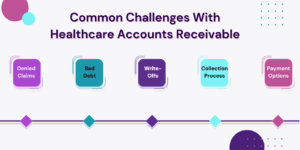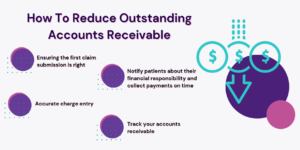Blog

Effectively managing and decreasing outstanding accounts receivable in your healthcare practice might seem challenging, especially without prior experience or a dedicated revenue cycle team. Many healthcare practices focus on patient care daily, and keeping track of services for reimbursement can become an oversight until it overwhelms your office.
While you can easily hire an RCM team to analyze your medical billing process and implement changes, we believe it’s important for healthcare practices and their staff to understand the process fully. This article explains what outstanding accounts receivable are, how this applies to healthcare, the most common challenges with medical accounts receivable, and how to improve your practice’s accounts receivable process.
What Are Outstanding Accounts Receivable?
Accounts receivable (AR) is debt from customers or clients for a service that has yet to be collected, similar to credit card companies loaning money to their carriers each month. Aged or outstanding accounts receivable refer to payments that have exceeded their required payment timeframe and are usually sent to debt collections to ensure payment from the customer. The longer an AR goes unpaid, the less likely the service provider will receive full payment or payment at all. Some companies even carry accounts receivable insurance to cover losses from bills paid off slowly or not at all.
There are two main types of accounts receivable: trade and non-trade accounts. Trade accounts are payments owed to the service provider from a customer. Non-trade accounts are payments owed to the company from other companies or organizations.
The accounts receivable process begins when the service provider sends their bill to the customer or, in the case of healthcare, the insurance provider. Most medical practices categorize ARs into ages:
- 1-30 days
- 31-60 days
- 61-90 days
- 91-120 days
How Does This Apply To Healthcare?
In healthcare, accounts receivable is the money owed to providers for treatment, ranging from yearly physicals from primary care physicians to hospital inpatient stays. Outstanding accounts receivable in healthcare are particularly challenging and unique because of the amount of money medical services can cost, the involvement of insurance companies and government programs, and the increased risk of late payments, also called bad debts.
One of the biggest challenges to receiving reimbursement from healthcare patients comes from the rise of high-deductible health plans, which increase patients’ financial responsibility rather than their insurance provider. When you combine high medical expenses with low healthcare outcomes, you end up with a medical system that demands an efficient accounts receivable process.
Read more: A Beginner’s Guide To End-To-End Revenue Cycle Management
Common Challenges With Healthcare Accounts Receivable
Some of the most common challenges with outstanding accounts receivable in healthcare include:
- Denied claims: Insurance companies can make it purposely difficult for healthcare providers to receive payment for services by denying claims. This is due to policies or guidelines that can be easily misinterpreted or missed. Insurance companies are for-profit organizations and financially benefit if they deny an entire claim’s cost, keeping their insured’s monthly payments and shifting the cost back onto the patient. One study found that insurers, on average, deny almost 1 in 5 claims, while others deny more than 1 in 3. The same study found that some companies may not accurately report their denials, denying anywhere from 2% to 50% of all claims.

- Bad debt: As the cost of healthcare rises, studies found that 74% of medical providers report higher financial burdens on their patients, even if they have insurance. Since the Affordable Care Act’s enactment in 2010, around 40 million Americans have enrolled in ACA plans, although this often means increased out-of-pocket expenses for medical bills. Despite having the highest healthcare spending per capita, the U.S. ranks last in healthcare outcomes. Comprehensive studies reveal that, after 120 days in accounts receivable, healthcare providers can expect to receive only ten cents for every dollar owed.
- Write-offs: Write-offs are forgiving a patient’s debt without payment. While considerate, write-offs of any amount severely impact your practice’s bottom line and become a larger issue for companies with outdated manual collection processes. Details about which services were written off can fall through the cracks and cause unpaid balances to accumulate.
- Disorganized collection process: For medical practices, timely payments are vital for functioning. Clear communication of care expenses is crucial, ideally before service. Streamlining the collections process involves compassionate staff communication, transparent payment terms, and efficient tools to avoid negative experiences, especially for patients already facing the stress of a diagnosis or injury.
- Disorganized payment options: Constricting your practice’s payment options to one or two choices limits your patient’s ability to pay bills and encourages them to choose other providers who offer more flexibility. One study found that 90% of healthcare providers still use paper and manual patient collection processes.
Read more: 5 Ways To Prevent & Appeal Medical Necessity Denials
How To Reduce Outstanding Accounts Receivable
Reducing your practice’s number of claims still in outstanding accounts receivable might sound simple, but it can quickly overwhelm medical staff as they try to collect payments and treat patients. Here are some of the first steps your medical practice can take to lower the amount of outstanding claims.
- Ensuring the first claim submission is right: It’s very important to get medical claims right on the first attempt since denied claims can cost $25 per claim for smaller practices and up to $117 for larger organizations. Submitting clean claims (an accurate claim approved with zero issues) maintains your reputation with insurance providers and government organizations and improves the chance they’ll renew their contracts with you and offer better reimbursement rates.
- Notify patients about their financial responsibility and collect payments on time: Providers can reduce delinquent payments by setting clear financial expectations before scheduled visits. Collecting copays upfront is crucial, as delayed payments lead to a 20% decrease in reimbursements. Integrating prompt invoice collection and offering partial payment plans help streamline the accounts receivable cycle, preventing revenue loss and bad debt write-offs.
- Accurate charge entry: After a patient visit, providers face the challenge of accurately entering service charges, a critical step in the medical billing process. Inaccurate charge entry, estimated at 1% of net charges, can lead to significant financial losses, potentially causing a healthcare organization expecting $250 million in annual revenue to lose $2.5 million. Miscoded charges result in revenue leakage and pose risks of underpayments and audit penalties.

- Track your accounts receivable: Monthly tracking helps providers identify potential revenue leaks and bad debt risks. Comparing AR trends over time, using a balance sheet, and analyzing metrics like aged debtors and collection rates provide insights into the health of the AR cycle. To calculate your average AR, choose a timeframe you want to track (months, quarters, years), add the starting and ending sums and divide by two. To track your outstanding claims, divide your current AR balance by your sales during the measured period and multiply the sum by the number of days in that period.
- Current AR Balance: Let’s say your current accounts receivable balance is $50,000.
- Credit Sales Revenue During Measured Period: For this example, consider that your credit sales revenue during the measured period (say a month) is $100,000.
- Number of Days in Measured Period: Assuming the measured period is one month, there are typically 30 days.
- In this example, it takes 15 days for your business to collect payments after providing healthcare services.
Contact Hansei Solutions
If you want to improve your outstanding accounts receivable process and increase cash flow, contact Hansei Solutions. Our medical billing and revenue cycle management team is dedicated to helping behavioral and non-hospital facilities, both small and large, improve their accounts receivable process. We’ll analyze your current procedure, identify your pain points, and provide a free demonstration of our services. Our goal is to reduce your staff’s workload and free them up to provide quality patient care.

Ready to focus on providing healthcare? Let us lighten your load.
We’re here to address your pain points and create growth opportunities for your organization. We’re passionate about what we do, and it shows in every interaction. Learn what makes us tick and schedule a demo today.